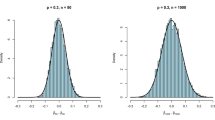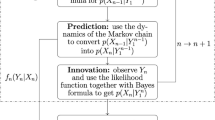Abstract
The problem of state estimation and system-structure detection for linear discrete-time systems with unknown parameters which may switch among a finite set of values is considered. The switching parameters are modeled by a Markov chain with known transition probabilities. Since the optimal solutions require exponentially growing storage and computations with time, a new method of generalized pseudo-Bayes algorithm (GPBA) is proposed to circumvent this problem by using a multi-stage measurement update technique. A minor modification is also presented to correct a defect of the Jaffer and Gupta method. Some simulation comparisons are included to illustrate the effectiveness of the proposed algorithms. It is then shown that, as compared with other GPBAs, a feature of the present GPBA is that it noticeably decreases the size of the required memory when the number of states in the Markov chain is large. The cost to be paid is a slight increase in the computing time.
Similar content being viewed by others
Explore related subjects
Discover the latest articles, news and stories from top researchers in related subjects.References
Ackerson, G.A. and Fu, K.S., (1970), On the state estimation in switching environments,IEEE Trans. Automat. Control AC-15(1), 10–17.
Akashi, H. and Kumamoto, H., (1977), Random sampling approach to state estimation in switching environments,Automatica 13, 429–434.
Birdwell, J.D., Castanon, D., and Athans, M., (1986), On reliable control system design,IEEE Trans. Systems Man Cybernet. SMC-16(5), 703–711.
Blair, W.P. and Sworder, D.D., (1975), Feedback control of a class of linear discrete systems with jump parameters and quadratic cost criteria,Internat. J. Control 21(5), 833–841.
Blom, H.A.P., (1984), An efficient filter for abruptly changing systems,Proc. 23rd IEEE Conf. on Decision and Control, pp. 656–658.
Blom, H.A.P., (1985), An efficient decision-making-free filter for processes with abrupt changes,Proc. IFAC Identification and System Parameter Estimation 1985, pp. 631–636.
Blom, H.A.P. and Bar-Shalom, Y., (1988), The interacting multiple model algorithm for systems with Markovian switching coefficients,IEEE Trans. Automat. Control AC-33(8), 780–783.
Chang, C.B. and Athans, M., (1978), State Estimation for Discrete Systems with Switching Parameters,IEEE Trans. Aerospace Electron. Systems AES-14(3), 418–425.
Chang, C.B. and Tabaczynski, J.A., (1984), Application of state estimation to target tracking,IEEE Trans. Automat. Control,AC-29(2) 98–109.
Chizeck, H.J., Willsky, A.S., and Castanon, D., (1986), Discrete-time Markovian-jump linear quadratic optimal control,Internat. J. Control 43(1), 213–231.
Gustafson, D.E., Willsky, A.S., Wang, J.Y., Lancaster, M.C., and Triebwasser, J.H., (1978), ECG/VCG rhythm diagnosis using statistical signal analysis, I. Identification of persistent rhythms,IEEE Trans. Biomed. Engng. BME-25(4), 344–353.
Griffiths, B.E. and Loparo, K.A., (1985), Optimal control of jump-linear gaussian systems,Internat. J. Control 42(4), 791–819.
Jaffer, A.G. and Gupta, S.C., (1971), On estimation of discrete processes under multiplicative and noise conditions,Inform. Sci. 3, 267–276.
Lainiotis, D.G., (1971), Optimal Adaptive Estimation: Structure and Parameter Adaptation,IEEE Trans. Automat. Control AC-16, 160–170.
Lainiotis, D.G., (1976), Partitioning: A unifying framework for adaptive systems,I: Estimation.Proc. IEEE 64, 1126–1142.
Mathews, V.J. and Tugnait, J.K., (1988), Detection and estimation with fixed lag for abruptly changing systems,IEEE Trans. Aerospace Electron. Systems AES-19(5), 730–739.
Moose, R.L., VanLandingham, H.F., and Zwicke, P.E., (1978), Digital set point control of nonlinear stochastic systems,IEEE Trans. Indust. Electron. Contr. Instrum. IECI-25(1), 39–45.
Moose, R.L., VanLandingham, H.F., and McCabe, D.H., (1979), Modeling and estimation for tracking maneuvering targets,IEEE Trans. Aerospace Electron. Systems AES-15(3), 448–456.
Ricker, G.G. and Williams, J.R., (1978), Adaptive tracking filter for maneuvering targets,IEEE Trans Aerospace Electron. Systems AES-14(1), 185–193.
Sugimoto, S. and Ishizuka, I., (1983), Identification and estimation algorithms for a Markov chain plus AR process,Proc. IEEE Internat. Conf. Acoustics, Speech and Signal Processing, ICASSP 83, pp. 247–250.
Tugnait, J.K. and Haddad, A.H., (1979), A detection-estimation scheme for state estimation in switching environments,Automatica 15, 477–481.
Tugnait, J.K., (1982a), Detection and estimation for abruptly changing systems,Automatica,18(5), 607–615
Tugnait, J.K., (1982b), Adaptive estimation and identification for discrete systems with Markov jump parameters,IEEE Trans. Automat. Control AC-27(5), 1054–1065.
Watanabe, K., (1989a), A multiple model adaptive filtering approach to fault diagnosis in stochastic systems, in R.J. Patton, P.M. Frank and R.N. Clark (eds.),Fault Diagnosis in Dynamic Systems Prentice-Hall, London, pp. 411–438.
Watanabe, K., (1989b), A decentralized multiple model adaptive filtering for discrete-time stochastic systems,ASME Trans. J. Dynamic Systems Measure. Control 111, 371–377.
Willsky, A.S., (1976), A survey of design methods for failure detection in dynamic systems,Automatica 12, 601–611.
Willsky, A.S., (1980), Failure detection in dynamic systems,AGARD No. 109.
Author information
Authors and Affiliations
Rights and permissions
About this article
Cite this article
Watanabe, K., Tzafestas, S.G. Generalized pseudo-Bayes estimation and detection for abruptly changing systems. J Intell Robot Syst 7, 95–112 (1993). https://doi.org/10.1007/BF01258214
Received:
Issue Date:
DOI: https://doi.org/10.1007/BF01258214




